+ Open data
Open data
- Basic information
Basic information
| Entry | Database: EMDB / ID: EMD-11338 | |||||||||||||||||||||
|---|---|---|---|---|---|---|---|---|---|---|---|---|---|---|---|---|---|---|---|---|---|---|
| Title | Kinesin binding protein (KBP) | |||||||||||||||||||||
 Map data Map data | Kinesin binding protein (KBP) sharpened/filtered cryo-EM density. | |||||||||||||||||||||
 Sample Sample |
| |||||||||||||||||||||
 Keywords Keywords | Kinesin / microtubules / kinesin binding protein / KBP / MOTOR PROTEIN | |||||||||||||||||||||
| Function / homology |  Function and homology information Function and homology informationtransport along microtubule / central nervous system projection neuron axonogenesis / mitochondrion transport along microtubule / kinesin binding / neuron projection maintenance / protein sequestering activity / microtubule cytoskeleton organization / in utero embryonic development / cytoskeleton / mitochondrion Similarity search - Function | |||||||||||||||||||||
| Biological species |  Homo sapiens (human) Homo sapiens (human) | |||||||||||||||||||||
| Method | single particle reconstruction / cryo EM / Resolution: 4.6 Å | |||||||||||||||||||||
 Authors Authors | Atherton J / Hummel JJA | |||||||||||||||||||||
| Funding support |  United Kingdom, United Kingdom,  Switzerland, Switzerland,  United States, 6 items United States, 6 items
| |||||||||||||||||||||
 Citation Citation |  Journal: Elife / Year: 2020 Journal: Elife / Year: 2020Title: The mechanism of kinesin inhibition by kinesin-binding protein. Authors: Joseph Atherton / Jessica Ja Hummel / Natacha Olieric / Julia Locke / Alejandro Peña / Steven S Rosenfeld / Michel O Steinmetz / Casper C Hoogenraad / Carolyn A Moores /     Abstract: Subcellular compartmentalisation is necessary for eukaryotic cell function. Spatial and temporal regulation of kinesin activity is essential for building these local environments via control of ...Subcellular compartmentalisation is necessary for eukaryotic cell function. Spatial and temporal regulation of kinesin activity is essential for building these local environments via control of intracellular cargo distribution. Kinesin-binding protein (KBP) interacts with a subset of kinesins via their motor domains, inhibits their microtubule (MT) attachment, and blocks their cellular function. However, its mechanisms of inhibition and selectivity have been unclear. Here we use cryo-electron microscopy to reveal the structure of KBP and of a KBP-kinesin motor domain complex. KBP is a tetratricopeptide repeat-containing, right-handed α-solenoid that sequesters the kinesin motor domain's tubulin-binding surface, structurally distorting the motor domain and sterically blocking its MT attachment. KBP uses its α-solenoid concave face and edge loops to bind the kinesin motor domain, and selected structure-guided mutations disrupt KBP inhibition of kinesin transport in cells. The KBP-interacting motor domain surface contains motifs exclusively conserved in KBP-interacting kinesins, suggesting a basis for kinesin selectivity. | |||||||||||||||||||||
| History |
|
- Structure visualization
Structure visualization
| Movie |
 Movie viewer Movie viewer |
|---|---|
| Structure viewer | EM map:  SurfView SurfView Molmil Molmil Jmol/JSmol Jmol/JSmol |
| Supplemental images |
- Downloads & links
Downloads & links
-EMDB archive
| Map data |  emd_11338.map.gz emd_11338.map.gz | 20.8 MB |  EMDB map data format EMDB map data format | |
|---|---|---|---|---|
| Header (meta data) |  emd-11338-v30.xml emd-11338-v30.xml emd-11338.xml emd-11338.xml | 11.2 KB 11.2 KB | Display Display |  EMDB header EMDB header |
| Images |  emd_11338.png emd_11338.png | 79.5 KB | ||
| Filedesc metadata |  emd-11338.cif.gz emd-11338.cif.gz | 5.6 KB | ||
| Archive directory |  http://ftp.pdbj.org/pub/emdb/structures/EMD-11338 http://ftp.pdbj.org/pub/emdb/structures/EMD-11338 ftp://ftp.pdbj.org/pub/emdb/structures/EMD-11338 ftp://ftp.pdbj.org/pub/emdb/structures/EMD-11338 | HTTPS FTP |
-Validation report
| Summary document |  emd_11338_validation.pdf.gz emd_11338_validation.pdf.gz | 488.3 KB | Display |  EMDB validaton report EMDB validaton report |
|---|---|---|---|---|
| Full document |  emd_11338_full_validation.pdf.gz emd_11338_full_validation.pdf.gz | 487.8 KB | Display | |
| Data in XML |  emd_11338_validation.xml.gz emd_11338_validation.xml.gz | 5.4 KB | Display | |
| Data in CIF |  emd_11338_validation.cif.gz emd_11338_validation.cif.gz | 6.1 KB | Display | |
| Arichive directory |  https://ftp.pdbj.org/pub/emdb/validation_reports/EMD-11338 https://ftp.pdbj.org/pub/emdb/validation_reports/EMD-11338 ftp://ftp.pdbj.org/pub/emdb/validation_reports/EMD-11338 ftp://ftp.pdbj.org/pub/emdb/validation_reports/EMD-11338 | HTTPS FTP |
-Related structure data
| Related structure data |  6zpgMC  6zphC  6zpiC M: atomic model generated by this map C: citing same article ( |
|---|---|
| Similar structure data |
- Links
Links
| EMDB pages |  EMDB (EBI/PDBe) / EMDB (EBI/PDBe) /  EMDataResource EMDataResource |
|---|
- Map
Map
| File |  Download / File: emd_11338.map.gz / Format: CCP4 / Size: 22.2 MB / Type: IMAGE STORED AS FLOATING POINT NUMBER (4 BYTES) Download / File: emd_11338.map.gz / Format: CCP4 / Size: 22.2 MB / Type: IMAGE STORED AS FLOATING POINT NUMBER (4 BYTES) | ||||||||||||||||||||||||||||||||||||||||||||||||||||||||||||
|---|---|---|---|---|---|---|---|---|---|---|---|---|---|---|---|---|---|---|---|---|---|---|---|---|---|---|---|---|---|---|---|---|---|---|---|---|---|---|---|---|---|---|---|---|---|---|---|---|---|---|---|---|---|---|---|---|---|---|---|---|---|
| Annotation | Kinesin binding protein (KBP) sharpened/filtered cryo-EM density. | ||||||||||||||||||||||||||||||||||||||||||||||||||||||||||||
| Projections & slices | Image control
Images are generated by Spider. | ||||||||||||||||||||||||||||||||||||||||||||||||||||||||||||
| Voxel size | X=Y=Z: 1.043 Å | ||||||||||||||||||||||||||||||||||||||||||||||||||||||||||||
| Density |
| ||||||||||||||||||||||||||||||||||||||||||||||||||||||||||||
| Symmetry | Space group: 1 | ||||||||||||||||||||||||||||||||||||||||||||||||||||||||||||
| Details | EMDB XML:
CCP4 map header:
| ||||||||||||||||||||||||||||||||||||||||||||||||||||||||||||
-Supplemental data
- Sample components
Sample components
-Entire : Kinesin binding protein cryo-EM density
| Entire | Name: Kinesin binding protein cryo-EM density |
|---|---|
| Components |
|
-Supramolecule #1: Kinesin binding protein cryo-EM density
| Supramolecule | Name: Kinesin binding protein cryo-EM density / type: complex / ID: 1 / Parent: 0 / Macromolecule list: all |
|---|---|
| Source (natural) | Organism:  Homo sapiens (human) Homo sapiens (human) |
| Molecular weight | Theoretical: 72 KDa |
-Macromolecule #1: KIF-binding protein
| Macromolecule | Name: KIF-binding protein / type: protein_or_peptide / ID: 1 / Number of copies: 1 / Enantiomer: LEVO |
|---|---|
| Source (natural) | Organism:  Homo sapiens (human) Homo sapiens (human) |
| Molecular weight | Theoretical: 71.913945 KDa |
| Recombinant expression | Organism:  |
| Sequence | String: MANVPWAEVC EKFQAALALS RVELHKNPEK EPYKSKYSAR ALLEEVKALL GPAPEDEDER PEAEDGPGAG DHALGLPAEV VEPEGPVAQ RAVRLAVIEF HLGVNHIDTE ELSAGEEHLV KCLRLLRRYR LSHDCISLCI QAQNNLGILW SEREEIETAQ A YLESSEAL ...String: MANVPWAEVC EKFQAALALS RVELHKNPEK EPYKSKYSAR ALLEEVKALL GPAPEDEDER PEAEDGPGAG DHALGLPAEV VEPEGPVAQ RAVRLAVIEF HLGVNHIDTE ELSAGEEHLV KCLRLLRRYR LSHDCISLCI QAQNNLGILW SEREEIETAQ A YLESSEAL YNQYMKEVGS PPLDPTERFL PEEEKLTEQE RSKRFEKVYT HNLYYLAQVY QHLEMFEKAA HYCHSTLKRQ LE HNAYHPI EWAINAATLS QFYINKLCFM EARHCLSAAN VIFGQTGKIS ATEDTPEAEG EVPELYHQRK GEIARCWIKY CLT LMQNAQ LSMQDNIGEL DLDKQSELRA LRKKELDEEE SIRKKAVQFG TGELCDAISA VEEKVSYLRP LDFEEARELF LLGQ HYVFE AKEFFQIDGY VTDHIEVVQD HSALFKVLAF FETDMERRCK MHKRRIAMLE PLTVDLNPQY YLLVNRQIQF EIAHA YYDM MDLKVAIADR LRDPDSHIVK KINNLNKSAL KYYQLFLDSL RDPNKVFPEH IGEDVLRPAM LAKFRVARLY GKIITA DPK KELENLATSL EHYKFIVDYC EKHPEAAQEI EVELELSKEM VSLLPTKMER FRTKMALT UniProtKB: KIF-binding protein |
-Experimental details
-Structure determination
| Method | cryo EM |
|---|---|
 Processing Processing | single particle reconstruction |
| Aggregation state | particle |
- Sample preparation
Sample preparation
| Buffer | pH: 7.5 |
|---|---|
| Vitrification | Cryogen name: ETHANE |
- Electron microscopy
Electron microscopy
| Microscope | FEI TITAN KRIOS |
|---|---|
| Specialist optics | Phase plate: VOLTA PHASE PLATE |
| Image recording | Film or detector model: GATAN K2 SUMMIT (4k x 4k) / Detector mode: COUNTING / Average electron dose: 42.0 e/Å2 Details: Movies were collected with a volta phase plate.Movies were dose weighted. |
| Electron beam | Acceleration voltage: 300 kV / Electron source:  FIELD EMISSION GUN FIELD EMISSION GUN |
| Electron optics | Illumination mode: FLOOD BEAM / Imaging mode: BRIGHT FIELD |
| Experimental equipment |  Model: Titan Krios / Image courtesy: FEI Company |
- Image processing
Image processing
| Startup model | Type of model: INSILICO MODEL / Details: De novo generated model in cryoSPARC2. |
|---|---|
| Final reconstruction | Resolution.type: BY AUTHOR / Resolution: 4.6 Å / Resolution method: FSC 0.143 CUT-OFF / Number images used: 258049 |
| Initial angle assignment | Type: MAXIMUM LIKELIHOOD |
| Final angle assignment | Type: MAXIMUM LIKELIHOOD / Software - Name: RELION |
 Movie
Movie Controller
Controller



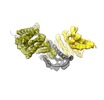



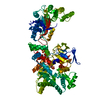
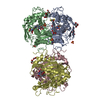
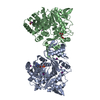
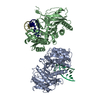
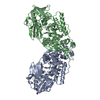
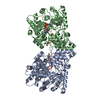
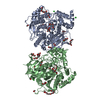
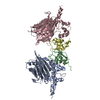
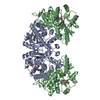
 Z (Sec.)
Z (Sec.) Y (Row.)
Y (Row.) X (Col.)
X (Col.)





















